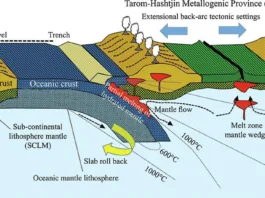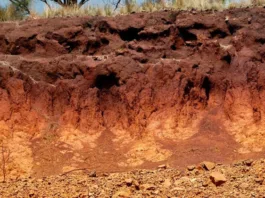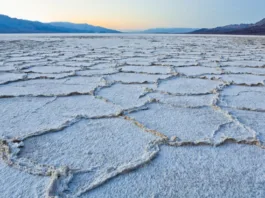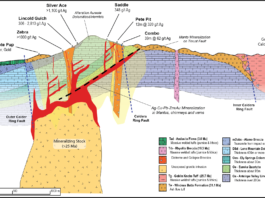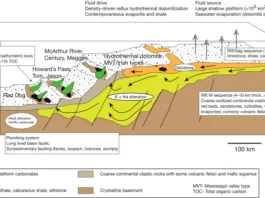Skarn deposits are a type of ore deposit formed by metasomatic replacement in carbonate rocks, typically limestone or dolomite. They are characterized by their association with skarn, a coarse-grained, silicate-rich metamorphic rock that is formed by the interaction of hot, magmatic fluids with carbonate rocks.

Skarn deposits are often found in the contact zones between intrusive igneous rocks, such as granites, and carbonate rocks. They can also form in other settings where carbonate rocks come into contact with hot, metal-rich fluids, such as around faults or in hydrothermal systems.
Skarn deposits have been historically significant as a source of copper, iron, and other metals. They were first recognized as an important mineral deposit type in the late 19th century in Europe and have since been found in many parts of the world. Today, skarn deposits remain an important source of metals, and are often associated with large-scale mining operations.
Contents
Types of Skarn Deposits
Skarn deposits are classified based on the type of igneous rock that gave rise to them. The main types of skarn deposits are:
- Calc-silicate Skarns: These are the most common type of skarn deposit and are associated with calc-alkaline igneous rocks such as diorite, quartz diorite, and granodiorite. They typically contain minerals such as garnet, pyroxene, and wollastonite.
- Magnetite Skarns: These are skarns that are associated with magnetite-rich rocks such as mafic or ultramafic intrusions. They are typically characterized by the presence of magnetite and pyroxene, as well as other minerals such as garnet and amphibole.
- Chlorite Skarns: These skarns are associated with rocks that are rich in chlorite, such as serpentinized ultramafic rocks. They typically contain minerals such as garnet, epidote, and actinolite.
- Tungsten Skarns: These are skarns that are enriched in tungsten and are typically associated with granitic rocks. They are characterized by the presence of minerals such as scheelite, wolframite, and molybdenite.
- Gold Skarns: These are skarns that are associated with gold mineralization and are typically associated with granitic rocks. They are characterized by the presence of minerals such as pyrrhotite, pyrite, and arsenopyrite.
Formation Processes and Mineralogy
Skarn deposits form when hot, mineral-rich fluids invade and react with the host rock, causing the formation of a metamorphic rock called skarn. Skarns can form in a variety of rock types, including limestones, dolomites, and shales, and the nature of the skarn that is formed is dependent on the composition of both the intruding fluid and the host rock.
During the formation of skarn, the invading fluid can cause the chemical alteration of the host rock, leading to the formation of new minerals. The alteration can also cause the formation of new textures in the rock, including foliation and banding. The new minerals formed during skarn formation can include a wide variety of minerals, including garnet, pyroxene, amphibole, and other silicate minerals.
Skarns can also contain ore minerals, which may precipitate from the mineral-rich fluids that are responsible for the formation of the skarn. Common ore minerals found in skarns include copper, iron, zinc, tungsten, molybdenum, and gold. The specific ore minerals that are present in a skarn deposit are dependent on the composition of the invading fluid and the host rock.
Overall, the mineralogy and texture of skarn deposits can be quite complex and variable, and the specific characteristics of any given deposit will be dependent on the specific geologic setting in which it formed.
Economic Significance and Uses
Skarn deposits are economically significant sources of metals such as copper, gold, silver, zinc, lead, tungsten, and iron, among others. They are important because they can be large and high-grade deposits, and can be mined using underground or open-pit methods.
Skarn deposits are particularly valuable for their tungsten and iron ore resources, as well as their high-grade copper and gold mineralization. They are also important sources of rare earth elements and other strategic metals, which are used in a wide range of industrial and technological applications.
In addition to their economic importance, skarn deposits are also of scientific interest because they provide valuable information about the geological processes that formed them, as well as the tectonic and magmatic history of the region in which they are found.
Examples of skarn deposits around the world
There are many skarn deposits around the world, some of which are significant sources of minerals. Here are a few examples:
- Bingham Canyon Mine, USA: This is one of the largest open-pit copper mines in the world, located in Utah, USA. It is primarily a copper-gold-molybdenum porphyry deposit, but also includes skarn mineralization with significant reserves of tungsten.
- Antamina Mine, Peru: This is a large copper-zinc-silver-gold skarn deposit located in the Andes Mountains of Peru. It is one of the largest producers of copper and zinc in the world.
- Yerington Mine, USA: This is a copper-gold skarn deposit located in Nevada, USA. It was historically an important source of copper, but has been inactive for several decades.
- Tungsten Queen Mine, USA: This is a historic tungsten skarn deposit located in North Carolina, USA. It was an important source of tungsten during World War II.
- Mittersill Mine, Austria: This is a tungsten skarn deposit located in the Austrian Alps. It is one of the largest tungsten deposits in the world.
- Daheishan Mine, China: This is a large iron-copper skarn deposit located in Liaoning Province, China. It is one of the largest iron deposits in China.
- Bayan Obo Mine, China: This is a large iron-REE-fluorite skarn deposit located in Inner Mongolia, China. It is the largest REE deposit in the world.
- Renison Bell Mine, Australia: This is a tin skarn deposit located in Tasmania, Australia. It is one of the largest tin deposits in the world.
- El Teniente Mine, Chile: This is a large copper skarn deposit located in the Andes Mountains of Chile. It is one of the largest copper mines in the world.
These are just a few examples of the many skarn deposits found around the world.
Summary of key points
- Mineral deposits are concentrations of minerals that can be economically extracted for use.
- There are many types of mineral deposits, including magmatic deposits, hydrothermal deposits, sedimentary deposits, metamorphic deposits, and vein deposits.
- Magmatic deposits form from the cooling and crystallization of magma and include porphyry, skarn, pegmatite, kimberlite, and carbonatite deposits.
- Hydrothermal deposits form from hot, mineral-rich fluids that are circulated through rocks, and include porphyry copper, epithermal gold, and Carlin-type gold deposits, among others.
- Sedimentary deposits form from the accumulation of sediment and include banded iron formations, sedimentary phosphate deposits, and evaporite deposits, among others.
- Metamorphic deposits form from the recrystallization of minerals in response to high heat and pressure and include some types of gold and copper deposits, as well as some types of gemstones.
- Vein deposits are narrow, often high-grade, mineralized zones that are typically hosted in fractures or faults in rocks, and can contain a variety of metals, such as gold, silver, copper, and zinc.
- Skarn deposits are contact metamorphic deposits that form when hot, mineral-rich fluids interact with carbonate rocks and can be important sources of copper, iron, tungsten, and other metals.
- Mineral exploration and mining involve a range of techniques, including geologic mapping, drilling, geophysical surveys, and geochemical analyses.
- Mineral deposits are important sources of raw materials for a variety of industries, including construction, energy, electronics, and manufacturing. However, mineral extraction can have significant environmental impacts, including habitat destruction, soil erosion, water pollution, and greenhouse gas emissions.


